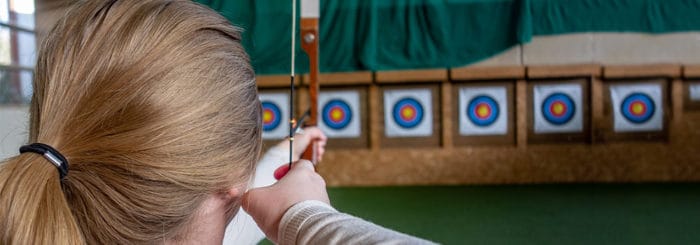Dry firing a bow is pulling and releasing the bowstring without an arrow on it. It’s usually one of the first things they tell you not to do when you pick up a bow, and for a good reason. Dry firing a bow can seriously damage it, and even render it unusable. It can even be dangerous to yourself and others.
Dry firing a bow is bad because when it happens, the bow vibrates intensely, which causes damage to the bow. This can completely ruin its cams, limbs, string, and more. It can also be dangerous to the archer and nearby people because parts might fly off. Most archers know not to dry fire a bow, but accidents do happen.
The main issue that causes dry fire is improper arrow nocking or the bowstring slipping out of the archer’s fingers. There are a few things you can do to avoid these accidents, which we’ll discuss in this post.
But first, I’ll detail everything you need to know if you’ve accidentally dry fire a bow, or if you’re just interested why it’s such a big no-no.
Let’s start.
How dry firing a bow damages it?
When you shoot a bow with an arrow, it simply releases the energy stored within the string and limb to the arrow. The heavier the draw weight on the bow bows, the more energy is released.
When you dry fire a bow, it doesn’t have an arrow to release its energy to. The bow then behaves in an unexpected manner, releasing the energy through vibrations and heat. These strong vibrations can completely ruin a bow and even be dangerous to nearby people.
Here’s a video that shows somewhat of an extreme example of the damage dry firing a bow can do to it:
How damaged the bow will be after being dry fire depends on the material and overall build of the bow. Lower quality bows can be completely ruined, while higher quality bows may only be damaged a bit or, in some cases, not at all.
Since draw weight is a big factor in how much a bow will be damaged by dry fire, compound bows are much more likely to be seriously damaged by it. Compound bows typically have much higher draw weights than recurve or traditional bows, so they store a lot more energy that will be translated to vibrations.
If you’re not sure what draw weight is or how to measure it, read about it in my previous post about measuring your bow’s draw weight.
Compound bows also involve more moving parts, that something can go wrong at. The more complex the system is, and the more parts involved, the more things can go wrong.
Though some bows would likely be damaged less than others, always play it safe and never dry fire a bow. Even if the bow isn’t visibly damaged by dry fire, it can be fractured and damage in less visible ways, and seriously dangerous to use.
What parts of the bow are likely to be damaged by dry fire?
The weaker parts of the bow are more likely to be damaged. Joints and connections between different parts can be broken, while weak material can be fractured. I mean, the entire bow can pretty much shatter and fly in different directions.
The parts that are more likely to be damaged by dry fire:
- Cams: They can be broken or bent, and the wires can get out of the tracks and wrap around.
- Limbs: can be disconnected from the riser, and the material can be fractured.
- Bowstring: can be completely broken, and just strained.
Obviously, other parts of the bow can be damaged by dry fire, but these are both the most likely and the most dangerous things that can be damaged.
Will dry firing a bow once ruin it?
Dry firing a bow once won’t necessarily ruin it: some bows can withstand dry fire with no damage, while others might completely ruin being dry-fired once. It depends on the type of bow, the quality of the bow, and the draw weight. Still, dry firing a bow is dangerous, and should always be avoided.
In any case, a bow that was dry-fired should not be used before it was inspected by a professional at an archery shop. Some damage, like bent axles, can’t easily be seen, so if you don’t know what you’re doing, don’t use the bow before you get it checked.
What to do if you dry fire your bow
I hope that after reading about dry firing a bow you won’t be trying it on purpose. But accidents do happen, so hopefully if it did, no one got hurt. After you’ve checked that you and everyone around you are safe, let’s discuss what you should do.
If you’ve accidentally dry fire a bow, the first thing you should do is inspect it, and get it to an archery shop. Your inspection is not enough, because some of the damage that can happen is not easily visible. Don’t use the bow before getting it checked by a professional.
The main reason you should do a quick inspection yourself is to know how urgent it is that you get the bow to an archery shop. Not all damage is equal, and there are things to look for.
If you see serious wear on your bowstring, or fractures in the limb, for example, you should take your bow to a professional as soon as possible. The reason is that this sort of damage can quickly derail. If your string tears, it’s a completely different state than a worn string.
Since your equipment is limited and there are a lot of things that can go wrong if you’ve dry shot a bow, you should take it to an archery shop even if you don’t see any damage.
Some things are harder, while others are completely invisible to the naked eye. For example, there can be microscopic fractures in the bow that are only visible under a microscope. Especially for compound bows, the damage can be really hard to see.
Let’s discuss what your initial inspection should include, and what to do when you take the bow to a professional archery shop.
1. Quickly inspect your bow
The first thing you should do before you start inspecting the bow is to bring it to a place where you can clearly look at it. You’ll need good lighting, and preferably a table. If you can get your hands on a magnifying glass it will come in handy.
The first thing you should do is inspect the bowstring for any tear or damage. If you see any sign of damage, you’ll have to get the bow to an archery shop as quickly as possible. If the string snaps, the bow will typically get even more damaged.
If possible, you should very carefully remove the bowstring off the bow. It’s important because the string is putting pressure on the limb, and can cause farther damage to them. You’ll need to reduce the stress the limbs put on the string, and remove the bowstring off the bow.
If you’ve never removed a bowstring off a bow, I’d skip inspecting the bow all together and just get the bow to a pro archery shop right away.
Now that you’re not at risk of derailing damage, start inspecting the limbs of the bow. Try looking for any sign of fractures. If you have a magnifying glass, use it to detect any small damage.
After you’ve checked the riser, check every other part of the bow to see if anything is fractured or out of place. Start with the cams and riser, and then move on to all other parts of the bow.
If everything seems fine, you can relax, but still, get the bow to an archery shop as soon as you can. Never use a bow that was dry fired without consulting a professional first.
Let’s now discuss what you should do when taking the bow to an archery shop.
2. Take the bow to a professional archery shop
The most important thing to note here is that you have to be honest with the person at the archery shop about dry firing the bow. If they don’t know there’s something wrong with the bow, they can’t know what to look for.
It might be a bit embarrassing to admit, but it important that you do. Believe me, you’re not the first person to go tp that shop with a bow that was dry fired.
In the shop, they’ll take your bow apart and inspect every part of it to assess the damage. They know exactly what to look for, to make sure your bow is good and safe to use. If there are any parts that need replacing, they’ll let you know.
If you’ve gone to an expert, you can usually be completely sure you’re in good hands. If they’ve given you the OK, you’ll be able to start shooting with the bow again.
Let’s now discuss how to avoid accidentally dry firing a bow in the first place, so it’ll never happen to you.
How to avoid accidentally dry firing a bow
Here’s a small secret. Dry fires are almost always accidental. There are a few things you can do to ensure that it never happens to you:
- Never let an inexperienced person use your bow without your supervision. People who’ve never touched a bow honestly don’t know that they shouldn’t draw it without an arrow. If you let someone handle your bow, make sure they know not to do it.
- Make sure you properly nock your arrows, and never draw a bow without a nocked arrow. Especially if you’re new to archery, it might not come easy to you, and you might want to use the advice of more experienced archers and even watch some videos online.
Nocking the arrow is one of the essential parts of every archer’s shot sequence. If you need more guidance on developing your shot sequence, read my post where I detailed the essential things to include in your shot sequence. Developing a good shot process will make you much more aware of the actions you take, including properly nocking the arrow. - Make sure that your arrows are not too light for your bow. Shooting an arrow that is too light will pretty much have the same effect of dry firing the bow. Ensure that your arrow weight is compatible with your bow.
If you follow these tips and try to stay safe, it will become much more unlikely that you accidentally dry fire your bow.
Conclusions
Dry firing a bow can be extremely dangerous to you and the people around you and cause serious damage to your bow. You should try to keep safe and always shoot properly, to avoid accidents. Needless to say, Never dry fire your bow on purpose – it’s extremely dangerous.
If you did have an accident happen, and you and people around you are safe, quickly inspect your bow and get it as quickly as possible to an expert shop to avoid additional damage. They’ll know how to dismantle it and properly inspect it.
I’m sure that after reading this post, you’re equipped with knowledge of how to avoid dry fire, and what to do in case it does happen. Stay safe!



